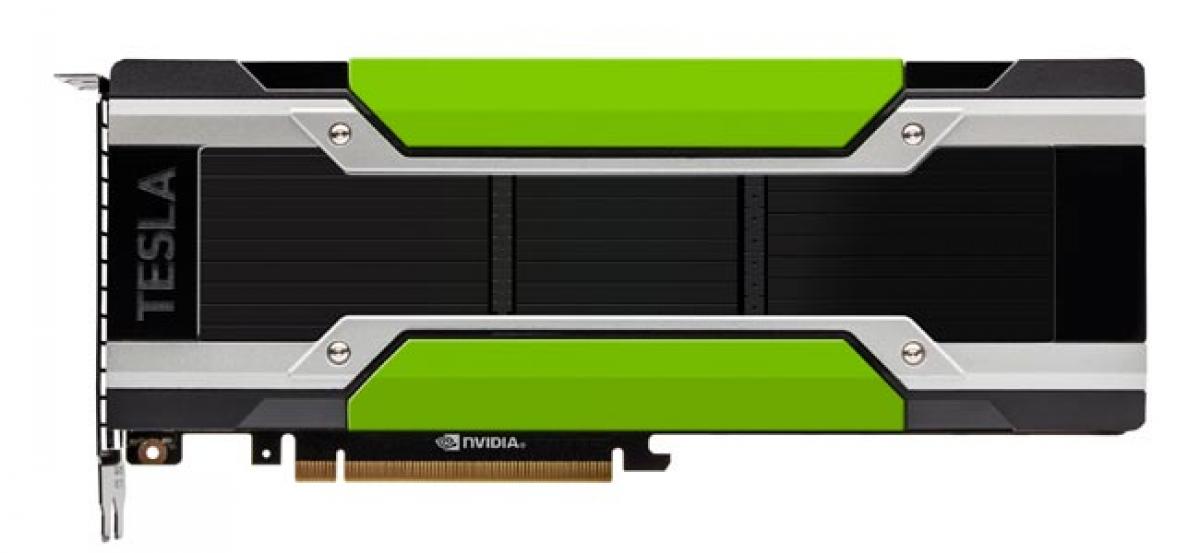Live
- Six Useful Strategies to Control Your Heart During the Pollution Season
- Phalodi Satta Bazar Predicts Close Race in Maharashtra Assembly Election 2024
- Federer Pays Heartfelt Tribute to Nadal Ahead of His Retirement: "An Epic Career"
- Odisha holds successful mega investors roadshow in Singapore
- PGTI Tour: Top stars to fight for honours in Servo Masters Golf
- SC upholds termination of LIC employee for absenting himself without intimation
- ‘Stone me or shoot me, won’t spare anyone,’ says Anil Deshmukh after discharge
- Siddaramaiah, Shivakumar turning Karnataka into Pakistan: K’taka BJP
- Zimbabwe records 70 suspected cholera cases, one death amid new outbreak
- Babri demolition day: No Assembly proceedings in Bengal on Dec 6
Just In
NVIDIA Tesla P100 Supercharges HPC Applications By More Than 30X


To meet the unprecedented computational demands placed on modern data centers, NVIDIA today introduced the NVIDIA® Tesla® P100 GPU accelerator for PCIe servers, which delivers massive leaps in performance and valuecompared with CPU-based systems.
Powered by Pascal Architecture, Tesla P100 Delivers Massive Leap in Data Center Throughput
Mumbai, India: To meet the unprecedented computational demands placed on modern data centers, NVIDIA today introduced the NVIDIA® Tesla® P100 GPU accelerator for PCIe servers, which delivers massive leaps in performance and valuecompared with CPU-based systems.
Demand for supercomputing cycles is higher than ever. The majority of scientistsare unable to secure adequate time on supercomputing systems to conduct their research, based on National Science Foundation data1. In addition,high performance computing (HPC) technologies are increasingly required to power computationally intensivedeep learning applications, whileresearchers are applying AI techniques to drive advances in traditional scientific fields.
The Tesla P100 GPU acceleratorfor PCIe meets these computational demands through the unmatched performance and efficiency of the NVIDIA Pascal™ GPU architecture. It enables the creation of “super nodes” that providethe throughput of more than 32 commodity CPU-based nodes and deliver up to 70 percent lowercapital and operational costs2.
“Accelerated computing is the only path forward to keep up with researchers’ insatiable demand for HPC and AI supercomputing,” said Ian Buck, vice president of accelerated computing at NVIDIA. “Deploying CPU-only systems to meet this demand would require large numbers of commodity compute nodes, leading to substantially increased costs without proportional performance gains. Dramatically scaling performance with fewer, more powerful Tesla P100-powered nodes puts more dollars into computing instead of vast infrastructure overhead.”
The Tesla P100 for PCIe is available in a standard PCIe form factor and is compatible with today’s GPU-accelerated servers.It is optimized to power the most computationally intensive AI and HPC data center applications. A single Tesla P100-powered server delivers higher performance than 50 CPU-only server nodes when running the AMBER molecular dynamics code3, and is faster than 32 CPU-only nodes when running the VASP material science application4.
Later this year, Tesla P100 accelerators for PCIe will power an upgraded version of Europe’s fastest supercomputer, the Piz Daint system at the Swiss National Supercomputing Center in Lugano, Switzerland.
“Tesla P100 accelerators deliver new levels of performance and efficiency to address some of the most important computational challenges of our time,” said Thomas Schulthess, professor of computational physics at ETH Zurich and director of the Swiss National Supercomputing Center. “The upgrade of 4,500 GPU accelerated nodes on Piz Daint to Tesla P100 GPUs will more than double the system’s performance, enabling researchers to achieve breakthroughs in a range of fields, including cosmology, materials science, seismology and climatology.”
The Tesla P100 for PCIe is the latest addition to the NVIDIA Tesla Accelerated Computing Platform. Key features include:
• Unmatched application performance for mixed-HPC workloads—Delivering 4.7 teraflops and 9.3 teraflops of double-precision and single-precision peak performance, respectively, a single Pascal-based Tesla P100 node provides the equivalent performance of more than 32 commodity CPU-only servers.
• CoWoS with HBM2 for unprecedented efficiency —The Tesla P100 unifies processor and data into a single package to deliver unprecedented compute efficiency. An innovative approach to memory design —chip on wafer on substrate (CoWoS) with HBM2 — provides a 3x boost in memory bandwidth performance, or 720GB/sec, compared to the NVIDIA Maxwell™ architecture.
• PageMigration Engine for simplified parallel programming— Frees developers to focus on tuning for higher performance and less on managing data movement, and allows applications to scale beyond the GPU physical memory size with support for virtual memory paging. Unified memory technology dramatically improves productivity by enabling developers to see a single memory space for the entire node.
• Unmatched application support— With 410 GPU-accelerated applications, including nine of the top 10 HPC applications, the Tesla platform is the world’s leading HPC computing platform.
Tesla P100 for PCIe Specifications
• 4.7 teraflops double-precision performance, 9.3 teraflops single-precision performance and 18.7teraflops half-precision performance with NVIDIA GPU BOOST™ technology
• Support for PCIe Gen 3 interconnect (32GB/sec bi-directional bandwidth)
• Enhanced programmability with Page Migration Engine and unified memory
• ECC protection for increased reliability
• Server-optimized for highest data center throughput and reliability
• Available in two configurations:
o 16GB of CoWoS HBM2 stacked memory, delivering 720GB/sec of memory bandwidth
o 12GB of CoWoS HBM2 stacked memory, delivering 540GB/sec of memory bandwidth
Availability
NVIDIA Tesla P100 GPU accelerator for PCIe-based systems is expected to be available beginning in Q4 2016 from NVIDIA reseller partners and server manufacturers, including Cray, Dell, Hewlett Packard Enterprise, IBM and SGI.
Keep Current on NVIDIA
Subscribe to the NVIDIA blog, follow us on Facebook, Google+, Twitter,LinkedIn and Instagram, and view NVIDIA videos on YouTube and images on Flickr.

© 2024 Hyderabad Media House Limited/The Hans India. All rights reserved. Powered by hocalwire.com






